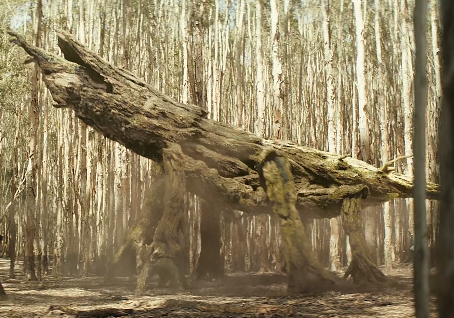Spore Mantis
| |||||||||||||||||||||||||||||||||||||||||||||||||||||||||||||
The Spore Mantis is a giant parasitic insect superspecies that appears in the 2017 Legendary Pictures film Kong: Skull Island.
Name
The Spore Mantis' scientific name, Phasmid Sylas, comes from phasmid, which is an order of insects, and the Latin word sylas, meaning “forest.”
Design
Both the body and limbs of the Spore Mantis resemble fallen trees. In fact, bark is a part of the species' epidermis. Beneath this deceptive layer lies a parasitic slug-like creature.[1]
Behavior
Spore Mantises are carnivores. They are less aggressive than some of the other predators on Skull Island, with one being repelled by gunfire, withdrawing to avoid a potential fight with a Skullcrawler.
History
- Kong: Skull Island (2017)
Monsterverse
Kong: Skull Island
While attempting to contact the other members of his team, Jack Chapman sat down on a fallen log, which suddenly began to move. Chapman fell off the log, which revealed itself as a Spore Mantis. Chapman scrambled to recover his machine gun and fired it at the creature, damaging its wood-like armor. After calling out several times, the Spore Mantis turned and walked away. Confused, Chapman turned around, only to be confronted by a Skullcrawler, which promptly killed and ate him.
Abilities
Camouflage
With its tree-like body, the Spore Mantis can blend in with surrounding forests.
Physical abilities
Spore Mantises possess "bone-crushing" jaws.[1]
Sap
Spore Mantises digest and envelop their prey with a "protein-rich sap." As a result, their victims can easily be identified in their "crystalline amber" feces.[1]
Books
Kong and Me
A Spore Mantis walked behind Jia as she played hide-and-seek with Kong. She described them as "logs with legs."
Comics
- Skull Island: The Birth of Kong #3 (2017) [profile]
- Godzilla x Kong: The Hunted (2024) [taxidermy]
Gallery
- Main article: Spore Mantis/Gallery.
Roar
|
In other languages
| ||||||||
References
This is a list of references for Spore Mantis. These citations are used to identify the reliable sources on which this article is based. These references appear inside articles in the form of superscript numbers, which look like this: [1]
|
Comments
Showing 12 comments. When commenting, please remain respectful of other users, stay on topic, and avoid role-playing and excessive punctuation. Comments which violate these guidelines may be removed by administrators.


